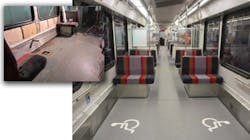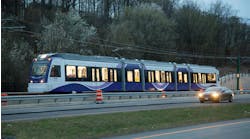RTD of Denver retrofits its light-rail cars for better accessibility accommodation
When Regional Transportation District (RTD) of Denver patrons board any of the agency’s light-rail vehicles these days with a wheelchair, scooter or walker, they are presented with long, open spaces where they can settle in for a ride. A 60-inch circle of maneuverability means they can easily move to and through these areas and mobility devices now fit comfortably within the space without extending into the aisle. A new stop request switch mounted on the wall next to each of these spaces allows passengers to notify the rail operator of the need for assistance when deboarding at the next station.
These are substantial changes over what previously had been the case, when RTD’s rail cars for decades had provided passengers using mobility devices with two areas to use that were smaller than the newly redefined spaces. Riders had to flip up a nearby seat to fit.
The desire for more boarding and maneuvering space ultimately led to legal action by the Colorado Cross-Disability Coalition (CCDC), a Denver-based organization that advocates for social justice for people with all types of disabilities. RTD finalized a class action settlement agreement in August 2017 and agreed to redesign the seating on all light rail cars to more ably accommodate passengers with disabilities. The agency agreed to complete the project in five years.
The retrofitting of 172 light-rail cars – and work to ensure that 29 new cars would meet the same standard – was finished in late May, in less than half the time that had been agreed to.
How did this happen?
Meet Phil Eberl, general superintendent of light rail vehicle maintenance. The 36-year RTD employee and his staff figured out a way to remove 16 seats from each light-rail vehicle – eight at each end – in two different rail car models and oversaw a team of dedicated employees to get the work done.
By completing the work in-house, RTD saved millions of public dollars, compared with the cost of having manufacturer Siemens take on the project instead. For Siemens to retrofit the cars, at $100,000 to $150,000 each, would have totaled $17.2 million to $25.8 million, Eberl estimates. Purchasing all new rail cars with the changes would be at least $4 million each – for a jaw-dropping $688 million.
Eberl didn’t have to seek outside help for this work because RTD’s light-rail maintenance team had extensive experience completing accident repairs and overhauls of its rail cars. The crew already was working to extend the life of the older set of 49 rail cars, acquired by RTD between 1994 and 2002. Eberl figured he could add the retrofit to the scope of work and roll the 123 newer cars in the existing fleet into the project. The team had grown more efficient over time, shortening each rail car midlife overhaul from six months to six weeks.
“I started thinking, if you guys can do this, we can do this (meet the agreed-upon deadline),” Eberl recalled. “We felt it was achievable.” After considering contingencies, he said, “I agreed to a five-year plan on day one, hoping I could reasonably beat it.”
As Eberl will tell you, altering the configuration of a light-rail car is not as easy as ripping the seats out. While the vehicles are strong, they are made as light as possible. All the seats are tied into the main structure of the car. Moving a seat mere inches introduces a major change, he noted, which as mentioned “is very expensive and very hard to do.”
With further study, Eberl realized that more accessible space could be provided by removing one row of seats from each end of every vehicle. Complicating matters was the fact that, depending upon the model of the car, the areas where the seats were to be removed housed either a heating system or sand boxes, the latter a traction enhancement feature on light-rail vehicles that drop sand onto the tracks when they get wet or slick. Both features protruded into the proposed wheelchair parking area, which would require a major redesign.
Without reconciling these issues, Eberl said, removing the seats wouldn’t fix the issue: “You still can’t park there.”
To address the heaters, Eberl found a suitable motor online and asked his staff whether they could fit it into the sidewall of the car. They showed him they could.
Changing the sand boxes on the newer rail cars required not just modifications, but also a safety analysis to bear out whether removing half of them would provide adequate traction. Eberl had observed that brand-new rail cars being made included sand boxes on just the lead axle. At RTD’s request, Siemens came to Denver to test the vehicles with a single sand box and was satisfied with the results. The agency also performed its own review for safety and approved the proposed change.
Removing the sand boxes created a hole in the floor, so replacement pieces had to be designed and installed that would not be problematic to those using the space. Eberl is pleased by the result. Speaking about the flooring changes at a public meeting in fall of 2017, he told an audience member, “I really don’t think you’ll feel it through your wheels.”
Since RTD began operating light rail, expanding service and modifying its infrastructure to accommodate four-car trains, the agency needed to buy 29 new cars. Each rail vehicle experiences between 75,000 and 100,000 miles of service each year, requiring a lot of maintenance. Eberl worked with Siemens to ensure that the newest vehicles in the fleet were configured to include increased space for mobility devices.
These cars also reflect a design change requested by RTD to include flip seats that are virtually hands-free and easily moved by a wheelchair or foot. Eberl acknowledged public complaints that some of the seats in the new vehicles “are too close to each other and not as roomy. But now, more people can sit.”
Eberl said he appreciates that RTD has the expertise, facilities and resources to take on major projects such as this. Other agencies don’t, he said, so they have to send the work out or buy new cars. Either has a big impact on operational costs.
Eberl’s biggest lesson from this work is that meeting the needs of every rider is hard. That said, he hopes people can appreciate that the agency is always considering – whether with this work or in numerous other ways – how to best serve the public.
“I’ve talked to some during this project who want all the seats removed,” Eberl said. “Some people want to sit or work on their laptop or read. Others want to take on their bike. I know that I can’t make everybody happy. But I hope people understand that we’re doing everything we can with the least negative impact.”


